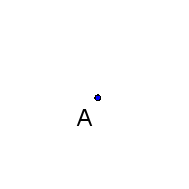Point (geometry): Difference between revisions
Jump to navigation
Jump to search

imported>Miguel Adérito Trigueira (Added diagrams) |
imported>Miguel Adérito Trigueira (neither ... nor ... instead of no ... or ...) |
||
| Line 3: | Line 3: | ||
[[Image:Point (geometry) circle notation.png|frame|Diagram of a point using an alternative "circle" notation]] | [[Image:Point (geometry) circle notation.png|frame|Diagram of a point using an alternative "circle" notation]] | ||
A '''point''' is a mathematical object in [[geometry]] which has a position but | A '''point''' is a mathematical object in [[geometry]] which has a position but neither [[length]] nor [[breadth]] nor [[depth]]. | ||
A point is made up of no other parts. | A point is made up of no other parts. | ||
The extremities of a [[line (geometry)|line]] segment are points. | The extremities of a [[line (geometry)|line]] segment are points. | ||
Revision as of 08:32, 17 September 2008
A point is a mathematical object in geometry which has a position but neither length nor breadth nor depth. A point is made up of no other parts. The extremities of a line segment are points.
A line is made up of an infinite number of points. Any line can be completely defined by two distinct points. Any plane can be completely defined by three distinct points that are not all part of the same line. Any two lines that lay on a single plane and are not parallel will intersect at a single point. Any three planes such that no plane is parallel to either of the other two will intersect at a single point.

